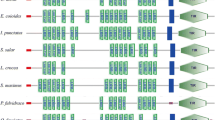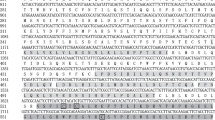Abstract
Toll-like receptors (TLRs) are a class of innate immune receptors that sense pathogens or their molecular signatures and activate signaling cascades to induce a quick and non-specific immune response in the host. Among various types of TLRs, TLR22 is exclusively present in teleosts and amphibians and is expected to play the distinctive role in innate immunity. This report describes molecular cloning, three-dimensional (3D) modeling, and expression analysis of TLR22 in rohu (Labeo rohita), the most commercially important freshwater fish species in the Indian subcontinent. The open reading frame (ORF) of rohu TLR22 (LrTLR22) comprised of 2,838 nucleotides (nt), encoding 946 amino acid (aa) residues with the molecular mass of ∼107.6 kDa. The secondary structure of deduced LrTLR22 exhibited the presence of signal peptide (1–22 aa), 18 leucine-rich repeat (LRR) regions (79–736 aa), and TIR domain (792–935 aa). The 3D model of LrTLR22-LRR regions together elucidated the horse-shoe-shaped structure having parallel β-strands at the concave surface and few α-helices at the convex surface. The TIR domain structure revealed alternate presence of five α-helices and β-sheets. Phylogenetically, LrTLR22 was closely related to common carp and exhibited significant similarity (92.2 %) and identity (86.1 %) in their amino acids. In rohu, TLR22 was constitutively expressed in all embryonic developmental stages, and tissue-specific analysis illustrated its expression in all examined tissues, highest was in liver and lowest in brain. In vivo modulation of TLR22 gene expression was analyzed by quantitative real-time PCR (qRT-PCR) assay following stimulation with lipopolysaccharide (LPS), synthetic double stranded RNA (polyinosinic-polycytidylic acid), and bacterial (Aeromonas hydrophila) RNA. Among these ligands, bacterial RNA most significantly (p < 0.05) induced TLR22 gene expression in most of the tested tissues. In A. hydrophila infection, induction of TLR22 gene expression was also observed in majority of the tested tissues. Together, these data suggested that in addition to sensing other microbial signatures, TLR22 can recognize bacterial RNA and may play the important role in augmenting innate immunity in fish.








Similar content being viewed by others
References
Akira, S. (2009). Pathogen recognition by innate immunity and its signaling. Proceedings of the Japan Academy Series B, 85, 143–156.
Rauta, P. R., Samanta, M., Dash, H. R., Nayak, B., & Das, S. (2014). Toll-like receptors (TLRs) in aquatic animals: signaling pathways, expressions and immune responses. Immunology Letters, 158, 14–24.
Stafford, J., Stafford, J. L., Ellestad, K. K., Magor, K. E., Belosevic, M., & Magor, B. G. (2003). A toll-like receptor (TLR) gene that is up-regulated in activated goldfish macrophages. Developmental and Comparative Immunology, 27, 685–698.
Franch, R., Cardazzo, B., Antonello, J., Castagnaro, M., Patarnello, T., & Bargelloni, L. (2006). Full-length sequence and expression analysis of Toll-like receptor 9 in the gilthead seabream (Sparus aurata L.). Gene, 378, 42–51.
Oshiumi, H., Tsujita, T., Shida, K., Matsumoto, M., Ikeo, K., & Seya, T. (2003). Prediction of the prototype of the human Toll-like receptor gene family from the pufferfish, Fugu rubripes, genome. Immunogenetics, 54, 791–800.
Hirono, I., Takami, M., Miyata, M., Miyazaki, T., Han, H. J., Takano, T., Endo, M., & Aoki, T. (2004). Characterization of gene structure and expression of two toll-like receptors from Japanese flounder, Paralichthys olivaceus. Immunogenetics, 56, 38–46.
Rebl, A., Siegl, E., Koller, B., Fischer, U., & Seyfert, H. M. (2007). Characterization of twin toll-like receptors from rainbow trout (Oncorhynchus mykiss): evolutionary relationship and induced expression by Aeromonas salmonicida. Developmental and Comparative Immunology, 31, 499–510.
Jault, C., Pichon, L., & Chluba, J. (2004). Toll-like receptor gene family and TIR-domain adapters in Danio rerio. Molecular Immunology, 40, 759–771.
Xiao, X., Qin, Q., & Chen, X. (2011). Molecular characterization of a toll-like receptor 22 homologue in large yellow croaker (Pseudosciaena crocea) and promoter activity analysis of its 5′-flanking sequence. Fish & Shellfish Immunology, 30, 224–233.
Su, J., Heng, J., Huang, T., Peng, L., Yang, C., & Li, Q. (2012). Identification, mRNA expression and genomic structure of TLR22 and its association with GCRV susceptibility/resistance in grass carp (Ctenopharyngodon idella). Developmental and Comparative Immunology, 36, 450–462.
Matsuo, A., Oshiumi, H., Tsujita, T., Mitani, H., Kasai, H., Yoshimizu, M., et al. (2008). TLR22 recognizes RNA duplex to induce IFN and protect cells from Birnaviruses. Journal of Immunology, 181, 3474–3485.
FAO, NACA. (2003). Quarterly aquatic animal disease report (Asia and Pacific Region).
Campanella, J. J., Bitincka, L., & Smalley, J. (2003). MatGAT: an application that generates similarity/identity matrices using protein or DNA sequences. BMC Bioinformatics, 4, 29.
Tamura, K., Dudley, J., Nei, M., & Kumar, S. (2007). MEGA4: Molecular Evolutionary Genetics Analysis (MEGA) software version 4.0. Molecular Biology and Evolution, 24, 1596–1599.
Sali, A., & Blundell, T. L. (1993). Comparative protein modelling by satisfaction of spatial restraints. Journal of Molecular Biology, 234, 779–815.
Van Der Spoel, D., Lindahl, E., Hess, B., Groenhof, G., Mark, A. E., & Berendsen, H. J. (2005). GROMACS: fast, flexible, and free. Journal of Computational Chemistry, 26, 1701–1718.
Vriend, G. (1990). WHAT IF: a molecular modeling and drug design program. Journal of Molecular Graphics, 8, 52–56.
Chen, V. B., Arendall, W. B., 3rd, Headd, J. J., Keedy, D. A., Immormino, R. M., Kapral, G. J., et al. (2010). MolProbity: all-atom structure validation for macromolecular crystallography. Acta Crystallographica, Section D: Biological Crystallography, 66, 12–21.
Livak, K. J., & Schmittgen, T. D. (2001). Analysis of relative gene expression data using real-time quantitative PCR and the 2(−Delta Delta C (T)) Method. Methods, 25, 402–408.
Sahoo, B. R., Basu, M., Swain, B., Maharana, J., Dikhit, M. R., Jayasankar, P., & Samanta, M. (2012). Structural insights of rohu TLR3, its binding site analysis with fish reovirus dsRNA, poly I:C and zebrafish TRIF. International Journal of Biological Macromolecules, 51, 531–543.
Botos, I., Liu, L., Wang, Y., Segal, D. M., & Davies, D. R. (2009). The Toll-like Receptor 3: dsRNA signaling complex. Biochimica et Biophysica Acta, 1789, 667–674.
Kanther, M., & Rawls, J. F. (2010). Host-microbe interactions in the developing zebrafish. Current Opinion in Immunology, 22, 10–19.
Peterson, B. C., Bosworth, B. G., & Bilodeau, A. L. (2005). Differential gene expression of IGF-I, IGF-II, and Toll-like receptors 3 and 5 during embryogenesis in hybrid (channel × blue) and channel catfish. Comparative Biochemistry and Physiology Part A: Molecular & Integrative Physiology, 141, 42–47.
Samanta, M., Swain, B., Basu, M., Panda, P., Mohapatra, G. B., Sahoo, B. R., & Maiti, N. K. (2012). Molecular characterization of toll-like receptor 2 (TLR2), analysis of its inductive expression and associated down-stream signaling molecules following ligands exposure and bacterial infection in the Indian major carp, rohu (Labeo rohita). Fish & Shellfish Immunology, 32, 411–425.
Samanta, M., Basu, M., Swain, B., Panda, P., & Jayasankar, P. (2013). Molecular cloning and characterization of Toll-like receptor 3, and inductive expression analysis of type I IFN, Mx and pro-inflammatory cytokines in the Indian carp, rohu (Labeo rohita). Molecular Biology Reports, 40, 225–235.
Swain, B., Basu, M., & Samanta, M. (2012). Molecular cloning and characterization of nucleotide binding and oligomerization domain-1 (NOD1) receptor in the Indian major carp, rohu (Labeo rohita), and analysis of its inductive expression and down-stream signalling molecules following ligands exposure and Gram-negative bacterial infections. Fish & Shellfish Immunology, 32, 899–908.
Swain, B., Basu, M., Sahoo, B. R., Maiti, N. K., Routray, P., Eknath, A. E., & Samanta, M. (2012). Molecular characterization of nucleotide binding and oligomerization domain (NOD)-2, analysis of its inductive expression and down-stream signalling following ligands exposure and bacterial infection in rohu (L. rohita). Developmental and Comparative Immunology, 36, 93–103.
Lv, J., Huang, R., Li, H., Luo, D., Liao, L., Zhu, Z., & Wang, Y. (2012). Cloning and characterization of the grass carp (Ctenopharyngodon idella) Toll-like receptor 22 gene, a fish-specific gene. Fish & Shellfish Immunology, 32, 1022–1031.
Hoshino, K., Takeuchi, O., Kawai, T., Sanjo, H., Ogawa, T., Takeda, Y., Takeda, K., & Akira, S. (1999). Cutting edge: Toll-like receptor 4 (TLR4)-deficient mice are hypo-responsive to lipopolysaccharide: evidence for TLR4 as the Lps gene product. Journal of Immunology, 162, 3749–3752.
Basu, M., Maiti, N. K., & Samanta, M. (2013). Toll-like receptor (TLR) 4 in mrigal (Cirrhinus mrigala): response to lipopolysaccharide treatment and Aeromonas hydrophila infection. International Research Journal of Biological Sciences, 2, 20–27.
Ding, X., Lu, D. Q., Hou, Q. H., Li, S. S., Liu, X. C., Zhang, Y., et al. (2012). Orange-spotted grouper (Epinephelus coioides) toll-like receptor 22: molecular characterization, expression pattern and pertinent signaling pathways. Fish & Shellfish Immunology, 33, 494–503.
Seya, T., Matsumoto, M., Ebihara, T., & Oshiumi, H. (2009). Functional evolution of the TICAM-1 pathway for extrinsic RNA sensing. Immunological Reviews, 227, 44–53.
Ando, T., Suzuki, H., Nishimura, S., Tanaka, T., Hiraishi, A., & Kikuchi, K. (2006). Characterization of extracellular RNAs produced by the marine photosynthetic bacterium Rhodovulum sulfidophilum. Journal of Biochemistry, 139, 805–811.
Saurabh, S., Mohanty, B. R., & Sahoo, P. K. (2011). Expression of immune-related genes in rohu Labeo rohita (Hamilton) by experimental freshwater lice Argulus siamensis (Wilson) infection. Veterinary Parasitology, 175, 119–128.
Eberle, F., Sirin, M., Binder, M., & Dalpke, A. H. (2009). Bacterial RNA is recognized by different sets of immune receptors. European Journal of Immunology, 39, 2537–2547.
Acknowledgments
The work was supported by the grant of National Fund for Basic Strategic and Frontier Application Research in Agriculture (NFBSFARA/BS-4003) and National Agricultural Innovation Project (NAIP/ C4-C30018) of the Indian Council of Agricultural Research (ICAR), Govt. of India. We express our sincere gratitude to Dr. A. Bandyopadhyay and Dr. S. Kochar, National Coordinators, NFBSFARA and NAIP-Comp-4, for meticulous suggestions and help. We thank Dr. P. Routray, Principal Scientist, Aquaculture Production and Environment Division, CIFA, for hatchery facility.
Author information
Authors and Affiliations
Corresponding author
Electronic Supplementary Material
Below is the link to the electronic supplementary material.
Fig. S1
Procheck analysis of rohu TLR22 domains. Ramachandran plot analysis of (a) LrTLR22-ECD and (b) LrTLR22-TIR domain. (GIF 198 kb)
Fig. S2
MD trajectory analysis of LrTLR22-ECD and TIR domains. RMSD graph of (a) LrTLR22-ECD and (b) LrTLR22-TIR domain. RMSF graph of (c) LrTLR22-ECD and (d) LrTLR22-TIR domain. Flipping regions are shown within the arc. (GIF 79 kb)
Fig. S3
Multiple sequence alignment among LRR motifs of TLR22. The LRR motifs of various species including rohu were predicted by SMART and were aligned by CLUSTALW. Aligned file was submitted in ESPript 3. to build blocks. The black background boxes represented strictly conserved regions and other boxes represented well-conserved (> 50 %) regions. (GIF 333 kb)
(GIF 321 kb)
Fig. S4
Multiple sequence alignment among TIR domains of TLR22. The TIR domains of various species including rohu were predicted by SMART and were aligned by CLUSTALW. Aligned file was submitted in ESPript 3.0 to build blocks. The black background boxes represented strictly conserved regions and other boxes represented well-conserved (> 50 %) regions. (GIF 147 kb)
Fig. S5
PCR amplification of TLR22 from genomic and cDNA template. PCR was carried out in a 50 μl reaction mixture using rohu genomic DNA (lane:1) or cDNA (lane: 2) as template, and 10 μl of the PCR product was analyzed in 1 % agarose gel. (GIF 45 kb)
Rights and permissions
About this article
Cite this article
Samanta, M., Swain, B., Basu, M. et al. Toll-Like Receptor 22 in Labeo rohita: Molecular Cloning, Characterization, 3D Modeling, and Expression Analysis Following Ligands Stimulation and Bacterial Infection. Appl Biochem Biotechnol 174, 309–327 (2014). https://doi.org/10.1007/s12010-014-1058-0
Received:
Accepted:
Published:
Issue Date:
DOI: https://doi.org/10.1007/s12010-014-1058-0




